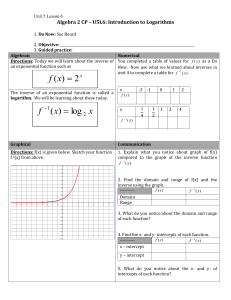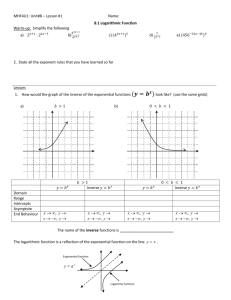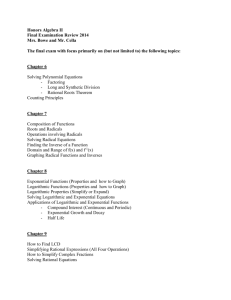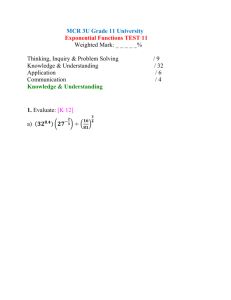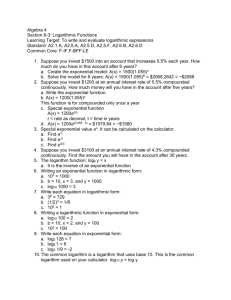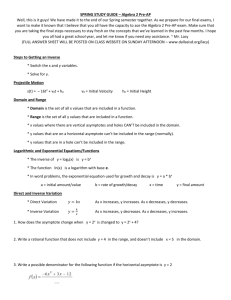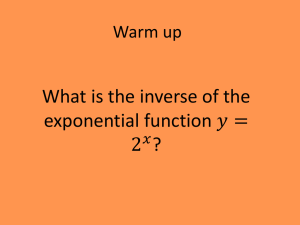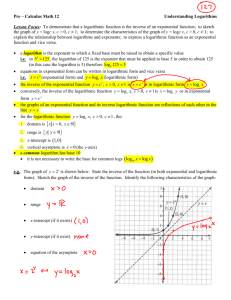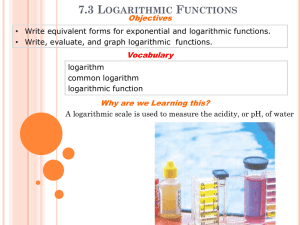x corresponds
advertisement
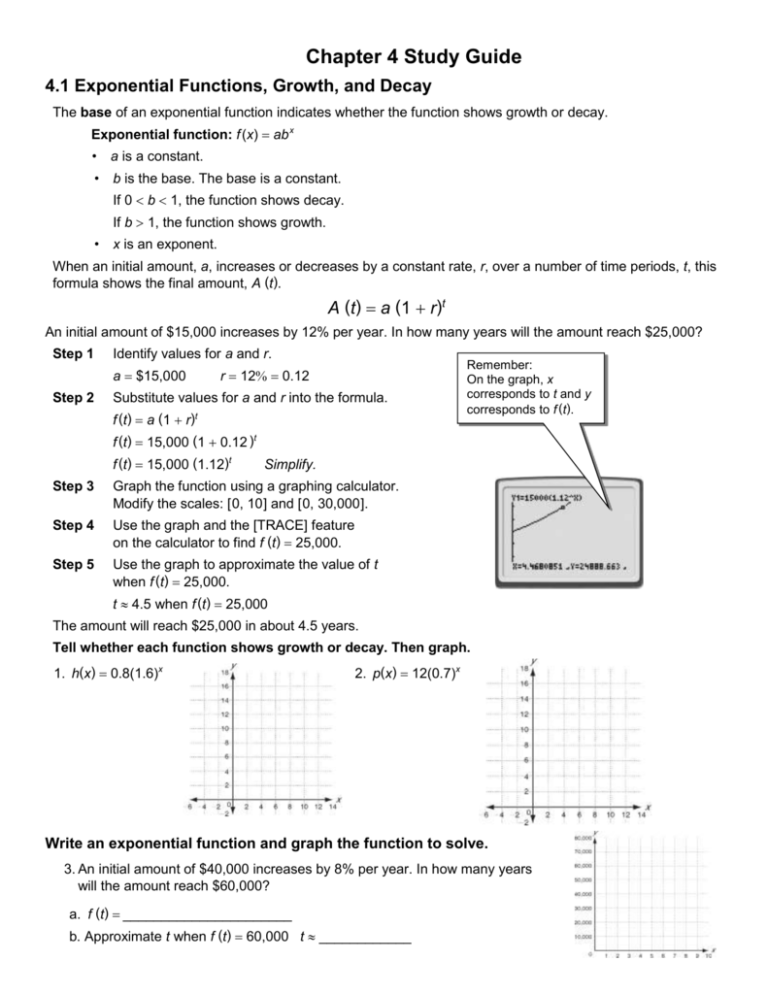
Chapter 4 Study Guide 4.1 Exponential Functions, Growth, and Decay The base of an exponential function indicates whether the function shows growth or decay. Exponential function: f (x) ab x • a is a constant. • b is the base. The base is a constant. If 0 b 1, the function shows decay. If b 1, the function shows growth. • x is an exponent. When an initial amount, a, increases or decreases by a constant rate, r, over a number of time periods, t, this formula shows the final amount, A (t). A (t) a (1 r)t An initial amount of $15,000 increases by 12% per year. In how many years will the amount reach $25,000? Step 1 Identify values for a and r. a $15,000 Step 2 r 12 0.12 Substitute values for a and r into the formula. f (t) a (1 r)t Remember: r the 12% 0.12 On graph, x corresponds to t and y corresponds to f (t). f (t) 15,000 (1 0.12 )t f (t) 15,000 (1.12)t Simplify. Step 3 Graph the function using a graphing calculator. Modify the scales: [ 0, 10 ] and [ 0, 30,000 ]. Step 4 Use the graph and the [TRACE] feature on the calculator to find f (t) 25,000. Step 5 Use the graph to approximate the value of t when f (t) 25,000. t 4.5 when f (t) 25,000 The amount will reach $25,000 in about 4.5 years. Tell whether each function shows growth or decay. Then graph. 1. h(x) 0.8(1.6)x 2. p(x) 12(0.7)x Write an exponential function and graph the function to solve. 3. An initial amount of $40,000 increases by 8% per year. In how many years will the amount reach $60,000? a. f (t) ______________________ b. Approximate t when f (t) 60,000 t ____________ 4.2 Inverses of Relations and Functions To graph an inverse relation, reflect each point across the line yx. Or you can switch the x- and y-values in each ordered pair of the relation to find the ordered pairs of the inverse. Inverse operations undo each other, like addition and subtraction, or multiplication and division. In a similar way, inverse functions undo each other. The inverse of a function f (x) is denoted f1(x). Use inverse operations to write inverse functions. Function: f(x) x 8 Subtraction is the opposite of addition. Use subtraction to write the inverse. Function: f(x) 5x Division is the opposite of multiplication. Use division to write the inverse. f 1( x ) Inverse: f1(x) x 8 Choose a value for x to check in the original function. Try x 1. f(x) x 8 f(1) 1 8 9 Substitute 9, into f1 (x). The output of the inverse should be 1. f1 (x) x 8 f 1 (9) 9 8 1 Think: (1, 9) in the original function should be (9, 1) in the inverse. Inverse: x 5 Choose a value for x to check in the original function. Try x 2. f(x) 5x f (2) 5 (2) 10 Substitute 10 into f1 (x). The output of the inverse should be 2. f 1( x ) x 10 f 1(10) 2 5 5 Think: (2, 10) in the original function should be (10, 2) in the inverse. Use inverse operations to write the inverse of each function. 5. f (x) x 4 ________________________________________ 7. f (x ) 2x 3 ________________________________________ 6. f ( x ) x 6 ________________________________________ 8. f (x) 14x ________________________________________ 4.3 Logarithmic Function A logarithm is another way to work with exponents in equations. If b x a, then logb a x. Use the definition of the logarithm to write exponential equations in logarithmic form and to write logarithmic equations in exponential form. Exponential Form Logarithmic Form 34 81 base, b 3 exponent, x 4 value, a 81 Logarithmic Form log5 125 3 log3 81 4 Exponential Form 5 3 125 base, b 5 exponent, x 3 value, a 125 If no base is written for a logarithm, the base is assumed to be 10. Example: log 100 2 because 1 0 2 100. Assume the base is 10. Write each exponential equation in logarithmic form. 9. 7 2 49 10. 6 3 216 11. 2 5 32 Write each logarithmic equation in exponential form. 12. log9 729 3 13. log2 64 6 Complete the tables. Graph the functions. 15. f (x) 4 x x 2 1 f (x) 1 16 1 4 f1(x) log4 x x f 1(x) 1 16 1 4 0 1 2 14. log 1000 3 4.4 Properties of Logarithms Product Property The logarithm of a product can be written as the sum of the logarithm of the numbers. logb mn logb m logb n where m, n, and b are all positive numbers and b 1 Simplify: log8 4 log8 16 log8 (4 16) log8 64 2 ] Quotient Property The logarithm of a quotient can be written as the logarithm of the numerator minus the logarithm of the denominator. m logb logb m logb n n where m, n, and b are all positive numbers and b 1 243 log3 243 log3 9 log3 log3 27 3 9 Simplify: Power Property The logarithm of a power can be written as the product of the exponent and the logarithm of the base. logb a p p logb a for any real number p where a and b are positive numbers and b 1 Simplify: log4 645 5 log4 64 5(3) 15 Inverse Properties The logarithm of bx to the base b is equal to x. logb bx x b raised to the logarithm of x to the base b is equal to x. b logb x x The logarithm undoes the exponent when the bases are the same. Simplify: log7 74x 4x The base of the log is 7 and the base of the exponent is 7. The exponent undoes the logarithm when the bases are the same. Simplify: 3log3 64 64 The base of the exponent is 3 and the base of the log is 3. Complete the steps to simplify each expression. 16. log6 54 log6 4 19. log6 65x 17. log2 128 log2 8 2. log2 164 18. log9 813 21. 2log2 3 x 4.5 Exponential and Logarithmic Equations and Inequalities Solve 6x 2 500. Step 1 Since the variable is in the exponent, take the log of both sides. 6x 2 500 log 6x 2 log 500 Use the Power Property of Logarithms: log ap p log a. Step 2 log 6x 2 log 500 (x 2) log 6 log 500 Step 3 “Bring down” the exponent to multiply. Isolate the variable. Divide both sides by log 6. (x 2) log 6 log 500 x2 Step 4 log 500 log 6 Solve for x. Subtract 2 from both sides. x Step 5 log 500 2 log 6 Use a calculator to approximate x. x 1.468 Solve: log 80x log 4 1 Step 1 Use the Quotient Property of Logarithms. log 80x log 4 1 log Step 2 Simplify. log Step 3 80 x 1 4 80 x 1 4 log 20x 1 Use the definition of the logarithm: if bx a, then logb a x. log10 20x 1 Remember: Use 10 as the base when the base is not given. 10 log10 20x = 101 20x = 101 Step 4 Solve for x. Divide both sides by 20. 10 20x 1 x 2 Solve and check. 22. 4x 32 23. 34x 90 24. 5x 3 600 25.log3 x4 8 26. log 4 log (x 2) 2 27. log 75x log 3 1 4.6 The Natural Base, e The natural logarithmic function, f (x) ln x, is the inverse of the exponential function with the natural base e, f (x) ex. The constant e is an irrational number. e 2.71828…. Properties of logarithms apply to the natural logarithm. In particular: ln 1 0 The base is e and e0 1. ln e 1 Think: e1 e. ln e x x e ln x x The natural logarithm and the exponential function are inverses, so they undo each other. Use properties of logarithms to simplify expressions with e or “ln.” Simplify: ln ex 2 Step 1 Use the Power Property. “Bring down” the exponent to multiply. ln ex 2 (x 2) ln e Simplify: e4 ln x Step 1 Use the Power Property. Write the exponent. e 4 ln x 4 e ln x x eln x Step 2 Simplify. eln x x4 ln e 1 Step 2 Simplify. (x 2) ln e x2 4 Simplify each expression. 28. ln e6x 29. ln e t 3 30. e 2 ln x 31.ln e1.8 32. ln ex 1 33. e7 ln x 4.7 Transforming Exponential and Logarithmic Functions Translations Vertical translation of f(x) f(x) k Shift k units up for k 0. Shift k units down for k 0. f(x) 2x g(x) 2x – 1 Think: k 1 y-intercept: y 20 1 1 1 0 Asymptote shifts down 1 unit: y 1 Horizontal translation of f (x) f(x h) Shift h units right for h 0. Shift h units left for h 0. f(x) 2x g(x) 2(x – 1) Think: h 1 1 y-intercept: y 20 1 2 1 2 Asymptote does not shift: y 0 Translations Vertical translation of f (x) f(x) k Shift k units up for k 0. Shift k units down for k 0. f (x) ln x g(x) ln x 1 Think: k 1 Asymptote does not shift: x 0. ln 1 0, so (1, 1) lies on the graph. Horizontal translation of f(x) f (x h) Shift h units right for h 0. Shift h units left for h 0. f (x) ln x g (x) ln (x 1) Think: h 1 Asymptote shifts left 1 unit: x 1. When x 0, y 0. So, (0, 0) lies on the graph. Find the y-intercept and asymptote for each function. Then graph each function and f (x) 2x on the same plane. 34. g(x) 2x 2 y-intercept: _______asymptote: _______ 35. g(x) 2x 2 y-intercept: _______asymptote: _______ Reteach Find the asymptote for each function. Then graph each function and f (x) ln x on the same plane. 36. g(x) ln x 2 37. g(x) ln (x 1) Asymptote: ____________ Asymptote: ____________ 4.8 Curve Fitting with Exponential and Logarithmic Models Data Set 1 x 1 0 1 2 3 y 2.2 3 7 27 127 First Difference 3 2.2 73 27 7 127 27 0.8 4 20 100 The first differences seem to increase by a constant factor. Check the ratios of the first differences. 4 5 0.8 20 5 4 100 5 20 The data set is exponential, with a constant ratio of 5. Data Set 2 x 1 0 1 2 3 y 4 1 2 5 8 1 (4) First Difference 3 2 (1) 52 85 3 3 3 The x-values increase by 1. First differences are constant. The data set is linear, not exponential. You can use the exponential regression feature on a graphing calculator to model exponential data. Use the exponential regression feature. Select ExpReg [ENTER]. Then enter the lists: L1, L2 [ENTER]. Look for ExpReg in the STAT CALC menu. 38. a. Use exponential regression to find a function that models this data. Time, t (min) 0 1 2 3 4 5 Bacteria, B(t) 250 360 485 686 964 1348 B(t) ___________________ b. When will the number of bacteria reach 2000? ____________________
